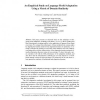Free Online Productivity Tools
i2Speak
i2Symbol
i2OCR
iTex2Img
iWeb2Print
iWeb2Shot
i2Type
iPdf2Split
iPdf2Merge
i2Bopomofo
i2Arabic
i2Style
i2Image
i2PDF
iLatex2Rtf
Sci2ools
IJCNLP
2005
Springer
2005
Springer
An Empirical Study on Language Model Adaptation Using a Metric of Domain Similarity
Abstract. This paper presents an empirical study on four techniques of language model adaptation, including a maximum a posteriori (MAP) method and three discriminative training models, in the application of Japanese Kana-Kanji conversion. We compare the performance of these methods from various angles by adapting the baseline model to four adaptation domains. In particular, we attempt to interpret the results given in terms of the character error rate (CER) by correlating them with the characteristics of the adaptation domain measured using the information-theoretic notion of cross entropy. We show that such a metric correlates well with the CER performance of the adaptation methods, and also show that the discriminative methods are not only superior to a MAPbased method in terms of achieving larger CER reduction, but are also more robust against the similarity of background and adaptation domains.
Adaptation Domains | Discriminative Training Models | IJCNLP 2005 | Language Model Adaptation | Natural Language Processing |
Related Content
| Added | 27 Jun 2010 |
| Updated | 27 Jun 2010 |
| Type | Conference |
| Year | 2005 |
| Where | IJCNLP |
| Authors | Wei Yuan, Jianfeng Gao, Hisami Suzuki |
Comments (0)

